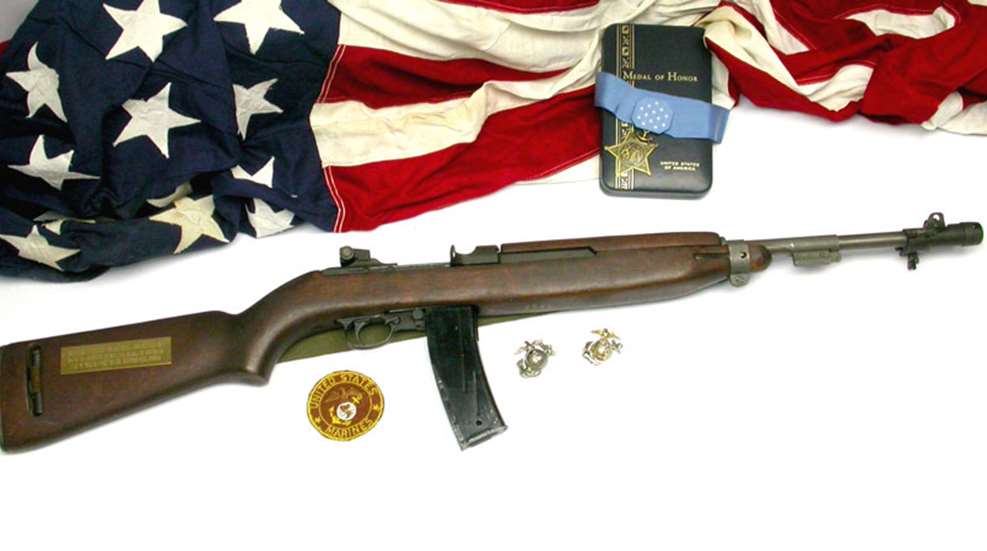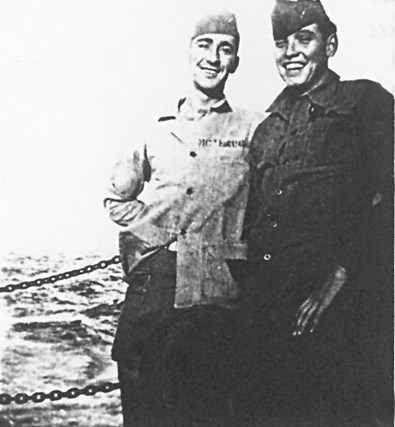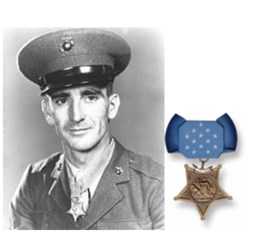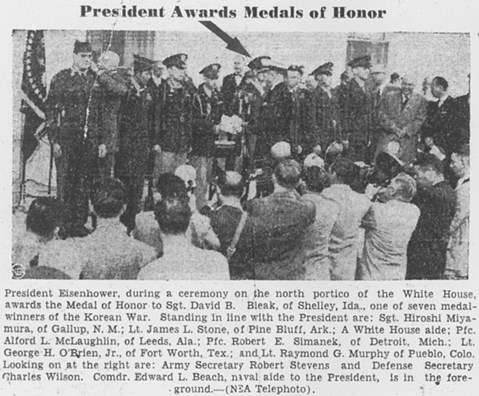
The “U.S. Carbine, Caliber .30 M1” is without a doubt one of the most popular “shooters” and collectible military firearms today, and when one is encountered at a gun show or auction, it seldom fails to generate a lot of attention. At least 6,117,827 military M1 and M2 carbines were produced during the bulk of World War II, the official number listed by The Carbine Club, although they freely admit known missing and/or incomplete records indicate there were probably more. The staggering record of more than 6 million firearms of a single model produced by 10 originally commissioned government contractors, all except Winchester Repeating Arms Company having no previous firearms manufacturing experience, and under the extreme pressures of wartime production, is an unparalleled testament to America’s former production might! (1)
Since World War II, millions more domestic and foreign commercial copies have been manufactured by a staggering number of firms. At least 43 firms have been identified, but the actual number of post-war carbines is unknown. Many early examples were assembled almost entirely from U.S. military surplus parts which were quite plentiful due to the fact there were literally hundreds of wartime subcontractors producing them. Some later carbines, however, only vaguely resembled the original carbine externally. (Note: One carbine collector’s gem, a near exact clone of the U.S. M1 Carbine was made by Howa Machinery Limited of Nagoya, Japan, for Thailand’s national military police between 1965-1966. Although 10,000 were produced, these are quite rare in the U.S., and are completely without Japanese manufacturer’s markings due to neutrality concerns at the time, but this is the topic for another article.) In recent years, several firms have even offered very high-quality reproductions manufactured to exact, original military specifications. In constant production in one form or another for more than 76 years, U.S. Carbines are perhaps the most commonly owned and widely recognized U.S. military arms in private hands today. Even the number of carbine collectors seems to grow unabated. The following is the story of one particular U.S. Carbine that stands out among the rest as “a very special carbine.” 
The .30 Carbine was never intended to be a main battle rifle, something that was widely understood in World War II, but a point apparently lost during the Korean War by many who tried to press it into service as an alternative to the M1 Garand. Instead, it was meant to be an improvement on, and a replacement for, the M1911 and M1911A1 pistols and the submachine guns in use at the time. It was designed to at least double their effective range, power and accuracy in a package that was easier to handle, carry and use by “secondary” troops, including vehicle crews, medical personnel, rear echelon soldiers and other support personnel not normally found on the front lines. It’s handiness, lighter weight and less-bulky ammunition also made it popular with combat noncoms and officers alike. Sadly, its regular frontline use in Korea was the basis of much of the criticism of it during that war. In reality, it should probably be considered the first true “Personal Defense Weapon.”
The cartridge, an evolution of the obsolete .32 Winchester Self-Loading cartridge, was diminutive by .30 caliber standards. The .30 U.S. Carbine (USC) round (7.62x33 mm) has been cussed and discussed ever since, but much of that criticism can be attributed to the 110-gr. FMJ ammunition issued to and used by the military. Law Enforcement issue and civilian use of Jacketed Soft Point (JSP) or Jacketed Hollow Point JHP projectiles between 1,718-2,092 feet per second velocity greatly increases its effectiveness, making it an effective anti-personnel round at moderate ranges. (Note: Most law enforcement engagements occur at less than 100 yards.) For comparison, the .30 USC round has 25 percent more muzzle energy than the 10 mm Auto, and 100 percent more than the .45 ACP. How often do you hear complaints about these “man-stoppers”?
Like many current pistol-caliber carbines, M1 and M2 Carbines have been utilized as “back-up” and/or “special purpose” weapons by countless law enforcement officers for more than seven decades, and have proven to be both handy and effective in that role. During more “enlightened” times, both were available as war surplus at a discount prices to law enforcement agencies and individual officers. I carried a personally owned, NFA-registered M2 Carbine as my “unofficial” backup gun in my state law enforcement duties for almost a decade, and the very carbine which is the subject of this article was likewise carried during its secondary career even longer by my one-time supervisor and lifelong friend, Elmer E. Walters (“Uncle Elmer”) Unlike mine, however, his carbine was actually “proven in combat” during several law enforcement engagements, one legendary incident in particular that I’m personally aware of. My decision to carry an M2 Carbine as a back-up gun early in my law enforcement career was definitely influenced by him.
Criticisms notwithstanding, on a lonely outpost named “Bruce” in the Bunker Hill (Hill 800) area of Korea on the night of Sept. 4-5, 1952, one of the best documented cases of the Korean War of a .30 Caliber U.S. Carbine helping to turn the tide of battle (utilizing “Ball, M1” FMJ ammunition, no less) was recorded in the following award of the Medal of Honor (MOH) on Oct. 27, 1953, by President Dwight D. Eisenhower to one young U.S. Marine Private First Class.
The President of the United States in the name of The Congress takes pleasure in presenting the MEDAL OF HONOR to
PRIVATE FIRST CLASS ALFORD L. MCLAUGHLIN
UNITED STATES MARINE CORPS
for service as set forth in the following:

According to available records, International Business Machine Corporation (IBM) manufactured 346,500 documented (“First Block”) M1 Carbines between August 1943 and May 1944. IBM Carbine Caliber .30 M1, serial No. 3933037, was manufactured at its No. 4 Poughkeepsie, N.Y., plant sometime between late February and early March, 1944. (Besides receivers, IBM also manufactured at least fourteen addition M1 Carbine parts at their No. 7 plant in Endicott, N.Y., many of which were delivered to the other M1 Carbine government manufacturers as needed.)
This particular carbine is still fitted with its original, undated IBM-produced barrel (oddly enough, it was IBM that pioneered a new barrel rifling technique which greatly increased production for all other manufacturers), but it exhibits “upgrades” afforded virtually all M1 Carbines still in the U.S. inventory at the end of World War II, sometimes referred to as “Korean War upgrades.” This minimally included redesigned sights adjustable for windage and elevation, a rotary safety (vs. the original push-button type), and a new barrel band with bayonet lug. While original M2 .30 caliber selective fire carbines (designated the T4) were manufactured only by the Winchester Repeating Arms Company and the Inland Division of General Motors in the waning days of World War II (the only carbines roll-marked “M2” on the receiver band), tens of thousands of M1 Carbines of other manufacturers were also upgraded to M2 selective-fire capability by military armorers prior to and during the Korean War. This officially relegated the semi-automatic M1 Carbine to be reclassified as “Limited Standard.” The conversion kit, designated “Kit T17” included the following modified parts: trigger housing assembly, improved slide, stronger and heavier, round (vs. flat) bolt, redesigned hammer, sear, disconnector (with new plunger and spring), and a beefed-up “Fat Boy” stock with four-rivet handguard (as opposed the original two-rivet type). A new magazine catch (with an extended lug for added support of the heavier 30-round magazine) was also usually included, but I have seen a few legitimate M2 carbines (like this one) with the earlier magazine catch. The 30-round magazine, so popular today, arrived on scene at about the same time the new M2s appeared, an obvious effort to provide more ammunition for the M2’s hungry appetite when fired in full-auto mode. The full-auto cyclic rate of the M2 is about 750-775 rounds per minute (r.p.m.), although I have seen official claims of M2 cyclic rates as high as 850-900 r.p.m. In my experience this is easily attributed to converted carbines that are still fitted with their original M1 flat bolts, which are much lighter and therefore reciprocate faster.
Additional M2-only conversion parts included a selector switch, selector switch spring, and a disconnect lever. Carbines officially modified to M2 configuration are usually found with receivers still marked with the original “M1” rollmark. A few were “overstamped” with a “2” over the original “1” and still other receivers (very late World War II, and some post-war production) were rollmarked with just the letter “M” so that a “1” or “2” could be hand-stamped later on, depending on final assembly. I have possessed M2s of all three variations, but IBM Carbine, serial number 3933037, is an example of the first type, modified by depot armorers at some point prior to the end of the Korean War. (3)
Rarely can a specific firearm be directly linked to a particular Medal of Honor, much less one that is a legal, privately owned NFA-registered firearm. A few firearms have been identified, but their whereabouts are most often unknown. One such notable case is the M1911 used by Sgt. Alvin C. York during his famous World War I MOH engagement. The serial number on his M1911 is known, 25468, but like the M1903 rifle he also used (whose serial number is unknown), its current location has been lost forever to history. Both are believed to have been “liberated” from the weapons storage onboard the troop ship that returned him to the United States. (4)
After leaving Korea McLaughlin unofficially took the IBM Carbine home with him as a “war trophy.” There is no available information at this time indicating whether this carbine was in M1 or M2 configuration when it was first issued to PFC Alford Lee McLaughlin before that fateful night on Outpost Bruce. This detail is absent from any officially record, but it’s almost certain that it was in its selective-fire, M2 configuration when it arrived stateside. Although it was nearly impossible for an individual to legally own a selective-fire M2 Carbine prior to 1968, especially one brought back as a war trophy, McLaughlin’s possession of the carbine if known was probably “overlooked” by his command due to his MOH status. (For example, in my geographical area, perhaps the largest military “complex” in the United States, I am personally aware of several past, nearly identical situations among my associates.) Undisputed, however, is that at some prior point in time, McLaughlin passed the carbine along to his friend and former NCO who personally registered it on Nov. 18, 1968, during the unprecedented 30-day Amnesty conducted by the Treasury’s Bureau of Alcohol, Tobacco & Firearms (November 1-30).
Elmer related to me that he and McLaughlin had spent much of their professional and leisure time together during the late winter of 1948 onboard the Light Cruiser U.S.S. Providence (LC 82), and during their ensuing Mediterranean assignment they became quick and lasting friends, possibly due to shared Native American Heritage. Crossing paths throughout their military careers continued and their friendship lasted until McLaughlin’s death on January 15, 1977. (Note: For some unknown reason many official published accounts incorrectly list McLaughlin’s death as occurring on January 14, 1977, however, his grave monument in Mount Hebron Cemetery in Leeds, Ala., clearly reads Jan. 15, 1977.) (5)
I ultimately received this very carbine in the (admittedly) most-lopsided trade of all time on Oct. 28, 2011, although the lengthy and cumbersome National Firearms Act (NFA) transfer requirements would prevent its physical delivery to me for another 10 months. At that time Elmer would only say that his wife, Linda, wanted it “out of their house.” He said she claimed it possessed “too much bad karma.” I wouldn’t understand the true meaning of this statement for another seven years. However, just knowing at the time it was the carbine carried all those years by one of my real-life heroes was more than enough for me. Thankful for my good fortune, I hastily processed the necessary NFA, and subsequent Virginia State Police registration paperwork.
Fast forward seven years. It would be at our weekly “Walters Family Breakfast Pow-Wow” that I would finally realize and fully appreciate the incredible piece of history I had been entrusted with. Immediately after sitting down in our usual seats at the local restaurant where we’d dined together at 6:30 a.m. every Friday morning for more than a decade, Elmer slowly and without speaking pushed a large, sealed manila envelope across the breakfast table toward me. Inside I found the astonishing documentation for the carbine: Amnesty papers, photographs of Elmer and McLaughlin together on the Light Cruiser U.S.S. Providence, a newspaper clipping of McLaughlin being awarded the MOH by President Eisenhower, and … a reproduced copy of the official MOH citation. Uncle Elmer had been characteristically and understandably cryptic over the years about the true origin of the carbine. But after much prodding, and just 29 days before passing away on Dec. 17, 2018, former USMC SSgt. Elmer E. Walters, 90, finally shared all of the details with me in a signed and dated letter.
"Elmer Elighia Walters, November 15, 1928 - December 17, 2018: Veteran of the U.S. Marine Corps., U.S. Navy and U.S. Army Reserves, Norfolk County Police Officer, Virginia State Game Warden Lieutenant, Virginia State Fire Marshall, Virginia State Police Homicide Investigator (Retired), U.S. Marshall.
Alford Lee McLaughlin, March 28, 1928 - January 15, 1977: Former Military Police Officer, USMC Master Sgt. (Retired), awarded the Medal of Honor for his heroic actions on Outpost Bruce, Bunker Hill, Korea, September 4-5, 1952.
Two U.S. Veterans, honorably retired from long, heralded careers in the military and law enforcement. Two true American heroes whose lives once intersected, forever connected in history by a U.S. Carbine, Caliber .30, serial number 3933037 … ."
(1) Of the 10 original U.S. corporations commissioned to manufacture .30 caliber carbines in World War II, only nine actually delivered completed carbines, with none of 3,542 original receivers produced by Irwin Pedersen (IP) passing U.S, Government acceptance. Most IP receivers were eventually reworked and assembled into completed carbines, remarked and certified under the supervision of Saginaw Steering Gear Division of the General Motors Corporation.
(2) This article incorporates public domain material from websites or documents of the United States Marine Corps.
(3) Carbines marked “M2” on the receiver ring, whether fitted with selective-fire (full auto capability) or not are still considered “machines guns” by the Bureau of Alcohol, Tobacco, Firearms and Explosives (BATFE) and must be registered as NFA weapons.
(4) Like the rest of his company, Sgt. York was actually issued an M1917 Enfield rifle, however both his fellow soldiers and relatives have stated he disliked the sights on the M1917 and traded his for an M1903, serial number unknown, before the historic fight.
(5) From photographic evidence, Mount Hebron Cemetery, Leeds, Alabama.
Additional Photo Credits: Elmer E. Walters

































